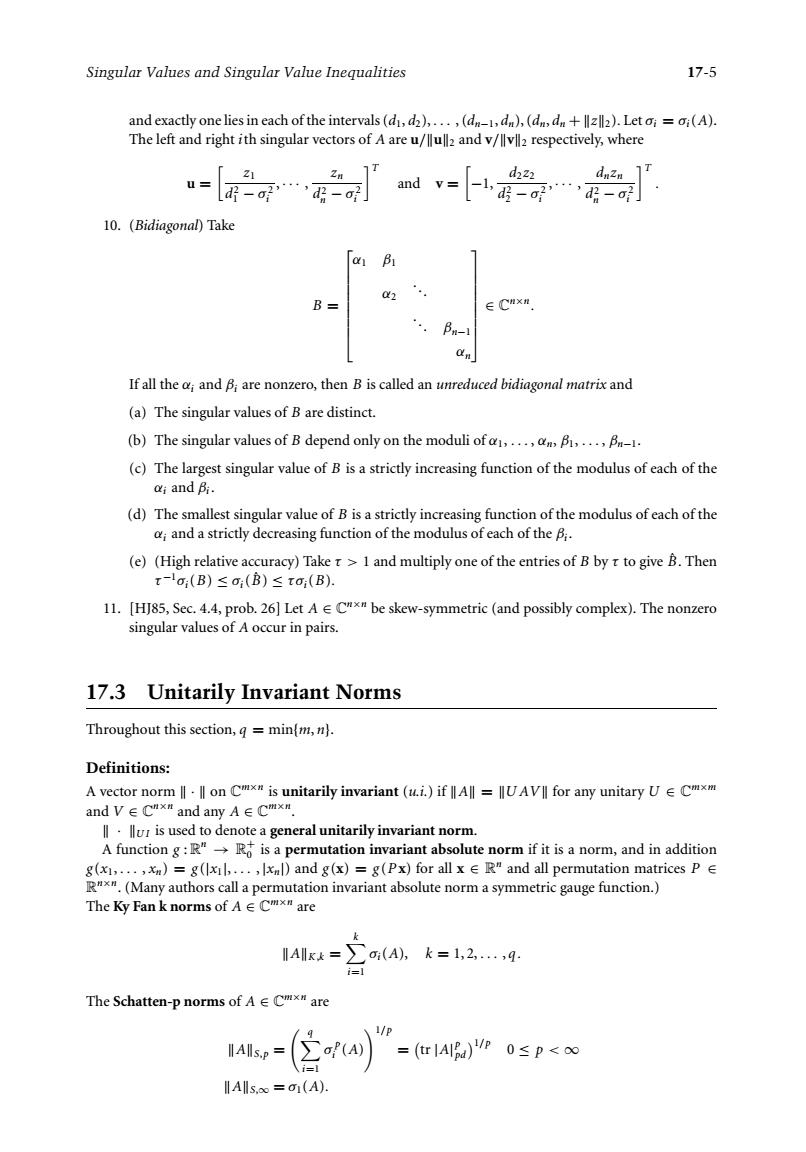正在加载图片...

Singular Values and Singular Value Inequalities 17-5 and exactly one lies in each of the intervals (d,d)...,(d,d )(dd+l).Let=(A). The left and right ith singular vectors of A are u/lul and v/vl2 respectively,where 1 10.(Bidiagonal)Take B= ∈CX If all the;and B:are nonzero,then B is called an unreduced bidiagonal matrix and (a)The singular values of B are distinct. (b)The singular values of B depend only on the moduli of... (c)The largest singular value of B isa strictly increasing function of the modulus of each of the ai and Bi. (d)The smallest singular value of B is n of the modulus of each of the (e)(High relative accuracy)Take>1 and multiply one of the entries of B byt to give B.Then T-la:(B)≤o,(B)≤ta(B). 11.[HJ85,Sec.4.4,prob.26]Let A Cx"be skew-symmetric(and possibly complex).The nonzero singular values of A occur in pairs. 17.3 Unitarily Invariant Norms Throughout this section,=min(m, Definitions: is unitarily invariant (ui.)if =UAV for any unitary UCm and VeC" and any A∈c hg:Rso de te a general unitarily invaria ,R is a permu 40 lute norm if it is a norm,and in addition (M =80l ,n)ar and al The Ky Fan Axk=∑m(A),k=1,2.,9 The Schatten-p norms of A Cmx"are P IAllsp=∑oP(A)=rIA3)p0≤p<o lAlls.o =a1(A). Singular Values and Singular Value Inequalities 17-5 and exactly one lies in each of the intervals (d1, d2), ... , (dn−1, dn), (dn, dn + z2). Let σi = σi(A). The left and right ith singular vectors of A are u/u2 and v/v2 respectively, where u = z1 d2 1 − σ2 i , ··· , zn d2 n − σ2 i T and v = −1, d2z2 d2 2 − σ2 i , ··· , dnzn d2 n − σ2 i T . 10. (Bidiagonal) Take B = ⎡ ⎢ ⎢ ⎢ ⎢ ⎢ ⎢ ⎢ ⎣ α1 β1 α2 ... ... βn−1 αn ⎤ ⎥ ⎥ ⎥ ⎥ ⎥ ⎥ ⎥ ⎦ ∈ Cn×n. If all the αi and βi are nonzero, then B is called an unreduced bidiagonal matrix and (a) The singular values of B are distinct. (b) The singular values of B depend only on the moduli of α1, ... , αn, β1, ... , βn−1. (c) The largest singular value of B is a strictly increasing function of the modulus of each of the αi and βi . (d) The smallest singular value of B is a strictly increasing function of the modulus of each of the αi and a strictly decreasing function of the modulus of each of the βi . (e) (High relative accuracy) Take τ > 1 and multiply one of the entries of B by τ to give Bˆ . Then τ −1σi(B) ≤ σi(Bˆ ) ≤ τσi(B). 11. [HJ85, Sec. 4.4, prob. 26] Let A ∈ Cn×n be skew-symmetric (and possibly complex). The nonzero singular values of A occur in pairs. 17.3 Unitarily Invariant Norms Throughout this section, q = min{m, n}. Definitions: A vector norm · on Cm×n is unitarily invariant (u.i.) if A=U AV for any unitary U ∈ Cm×m and V ∈ Cn×n and any A ∈ Cm×n. ·U I is used to denote a general unitarily invariant norm. A function g : Rn → R+ 0 is a permutation invariant absolute norm if it is a norm, and in addition g (x1, ... , xn) = g (|x1|, ... , |xn|) and g (x) = g (P x) for all x ∈ Rn and all permutation matrices P ∈ Rn×n. (Many authors call a permutation invariant absolute norm a symmetric gauge function.) The Ky Fan k norms of A ∈ Cm×n are AK,k = k i=1 σi(A), k = 1, 2, ... , q. The Schatten-p norms of A ∈ Cm×n are AS,p = q i=1 σ p i (A) 1/p = tr |A| p pd 1/p 0 ≤ p < ∞ AS,∞ = σ1(A).��